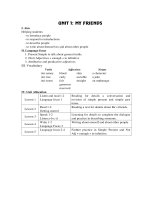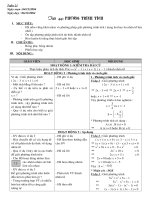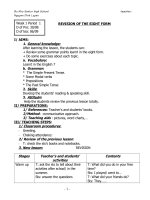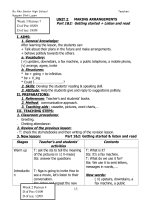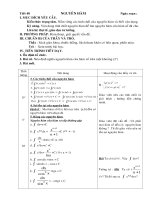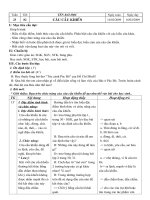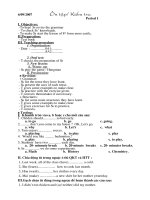Giao an anh 8 hai cot
Bạn đang xem bản rút gọn của tài liệu. Xem và tải ngay bản đầy đủ của tài liệu tại đây (508.79 KB, 111 trang )
Period: 1 Teaching day:.....................
REVISION
*Aims:
Revision and consolidation of English 7
* Objective :
by the end of the lesson students can remember some old knowledge of English 7.
* Teaching aids :
Posters
* Procedure:
Content Teacher's and
stdents' activities
1) Warmer
How are you ?
What's the weather like today ?
Did you have a good summer holiday?
2) New lesson
+ Too,So ; Either, Neither
Example
S1: I'm in class 7 A
S2: I'm, too/So am I
S1: I like beef.
S2: I do too/So do I
S1: I'm not late
S2: I'm not either
+ Exercise 1
State these setences with too, so, either, neither
a, I like playing soccer.
I.............................So..............................
b, He wants to go to market.
She........................./ So.........................
c, I watched TV last night.
Nam....................../ So.............................
d, Lan wasn't at school yesterday.
Mai....................../ Neither.........................
e, I don't like durians.
I........................./ Neither..........................
+ The Simple Future Tense
Form
S + will + V + O
Ss answer
Ss listen and coppy down
-Ss Do exercise orally
? What does Simple Future
express?
1
S + won't + V + O
Will + S + V + O ?
+ The Past Simple Tense
- To be
is , am = was ; Are + were
- Verbs
S + V(ed) + O
S + didn't + V + O
Did + S + V + O ?
Exercise 2
§iÒn ®óng d¹ng ®éng tõ
a, We .............(not watch) TV last night.
b, I often...............(play) badminto in the morning
c, Nam ..............(go ) to Ha noi yesterday.
d, He ............(return) home tomorrow.
e, What .......you ,............(do ) yesterday?
f, They ...........(not play) soccer next week.
3, Home work
Learn by heart the tenses
? What is the form?
? What does Past Simple
express?
? What is the form?
- Ss listen& coppy down
- Ss do exercise
2
Period: 2 Teaching day:.....................
Unit 1: My friends
- Lesson 1: - Listen & Read
- Language focus 1
* Aim: -
Reading the dialogue for details and revision of simple present and simple past
tenses.
* Objective: -
By the end of the lesson, students will be able to know more about Hoa-Lan-
Nien and to review simple present and simple past tense.
* Teaching aids: -
Text book, cards.
Procedure:
Content Teacher's
activities
Sts' activities
* Warm-up: (Pelmanism).
meet come live think send thought
receive met lived received came sent
* Pre-reading:
1. Pre-teach vocabulary:
- to seem (translation).
- a next door neighbor.
(explanation: a person who lives next to your
house).
- to look like (translation).
2. Pre-questions:
a. Is Nien Lan's friend or Hoa's friend?
b. How old is Nien?
c. Where does Nien live?
d. Is she a beautiful girl?
* While-reading:
Read the dialogue (p.10).
- Guide Ss how to
play the game.
- Present new
words on the
board.
- Guide Ss to read
new words.
- Check Ss'
memory by using
technique "Rub
out and
remember".
- Give Ss some
questions and ask
them to answer
them.
- Matching
words.
- Listen and
repeat.
- Copy down.
- Read new
words in
chorus.
- Read the
questions and
answer them
in pairs.
- Give feed
back?
3
Check the answers
Read the dialogue again
Answer the questions in exercise 2 on page
11.
* Answers:
a. Nien lives in Hue.
b. No, she doesn't.
c. The sentence is "She wasn't old enough to be in
my class".
d. At Christmas.
* Post-reading:
Gap-filling: (live-sent-be-come)
"Hoa (1) in Hue last year, but now she (2) in
Hanoi. Yesterday, Hoa's friend Nien (3) Hoa a
letter. Nien (4) Hoa's friend neighbor when Hoa
lived in Hue. She (5) yourger than Hoa. She
(6) to Hanoi in December.
* Homework:
Ask students to do exercise 1(a) ; 1(b) (page 16)
on their notebooks.
- Ask Ss to read
the dialogue.
- Give the correct
answers.
- Ask Ss to read
the dialogue again
and answer the
questions.
- Call on some
students to ask
and answer the
questions.
- Correct their
mistakes or
pronunciation.
- Ask Ss to use
the simple present
and simple past
tense to complete
paragraph 1a
(p.16)
- Provide some
verbs so that Ss
can use them to
fill in the gaps.
- Read the
dialogue and
check their
pre diction.
- Read the
dialogue
again and
answer the
question.
- Ask and
answer the
questions.
- Read the
paragraph and
fill in the
gaps with the
suitable
words
4
Period: 3 Teaching day:
Unit 1: My friends
- Lesson 2: + Speak (page 11).
+ Listen (page 12, 13).
* Aim: -
Listening for details to complete the dialogue and speak to describe someone.
* Objective: -
By the end of the lesson, students will be able to describe someone and
complete the dialogue by listening.
* Teaching aids: - Text book.
* Procedure:
Content Teacher's
activities
Sts' activities
* Warm-up: (Matching)
short to lín
fat gÇy
tall nhá,bÐ
thin thÊp
big bÐo, mËp
small cao
* Presentation:
Pre teach
curly xo¨n
blond vµng hoe
bold hãi
fair vµng nh¹t
- Ask Ss to match
- Show Ss a
picture of Mary
and ask them to
describe her hair,
her body build.
-Match.
- Describe Mary.
- Listen and
5
slim m¶nh mai
straight th¼ng
Ex: - She has long blond hair.
- She is short and thin.
----> Form:
* Practice:
1. Word one drill:
a. He / tall / thin.
b. She / short / shin.
c. He / short / fat.
d. long / black.
e. curly / blond.
f. straight / brown.
2. Practice speaking:
* Example:
S
1
: This person is short and thin. She has long
blond
hair.
S
2
: Is this Mary?
S
1
: Yes.
* Pre-listening:
Present the expressions in the box (p.12).
Explain and read the expression
Gap fill prediction.
(Dialogues p.12-13)
Give feedback.
* While listening:
Listen to the tape twice.
Compare with their prediction.
+ Answer key.
a. ...I'd like you to meet..
....Nice to meet you.
b. I'd like you to meet.......
- Explain the
structure.
- Supply the word
cues and ask Ss to
complete the
sentences.
- Ask Ss to look at
six people on page
11-12-Call on a
student to describe
one person, the
others have to
guess who he/she
is
- Give Ss some
expressions and
make sure they
know their mean
mgs.
- Get Ss to guess
and to complete
four dialogues on
page 12-13.
- Let students (to)
listen to the tape
twice.
copy down.
- Complete the
sentences based
on cues.
- Look at six
people and
describe them
- Listen and read
the expressions.
- Read the open
dialogues (p.12-
13) and fill in
the blanks with
the suitable
expressions.
- Listen to the
tape and then
check their
prediction.
6
S + have / has + adjectives + hair
S + be + adjectives
....It's a pleasure to meet you.
c. ....come and meet...
d. ....How do you do?
* Post-listening:
Practice the dialogues.
*Home work
Ex 3,4 workbook
- Pratise the
dialogues.
7
Period:4 Teaching day:.............
Unit 1: My friends
Lesson 3: - Getting started (p.10).
- Read (p.13 - 14).
* Aim: - Reading for specific information.
* Objective: - By the end of the lesson, students will be able to know more about Ba's
friend.
* Teaching aids: - Text books.
* Procedure:
Content Teacher's
activities
Sts' activities
* Warm-up: (Chatting).
Look at the pictures (p.10) and answer the
questions.
a. What are these students doing?
b. Do you like soccer / reading books...?
c. Whom do you like playing with?
* Pre-reading:
Pre-teach vocabulary:
- character (translation).
- an orphanage:
a place where children without parents live.
- reserved (ad)
- sociable translation
- (to) tell jokes: tell a story which makes people
laugh.
- sense of humor (translation).
-sociable (explainmation)
-generous (explainmation).
-to ennoy (translation).
T / F statements prediction:
a. Ba only has three friends - Bao, Song, Khai.
b. Ba and his friends have the same characters.
c. Bao-Song-Khai are quite reserved in public.
d. They all enjoy school and study hard.
Give feedback:
- Ask Ss to look at
four pictures on
page 10 and talk
about the activities
they want to do
after school or in
their free time.
- Present and give
the meaning of
new words.
- Guide Ss to read
them in chorus.
- Check Ss'
memory by using
technique "Rubb
out and
remember".
- Present the
statements on the
board.
- Set the scene:
These statements
are about Ba and
his friends, read
them and guess
which statements
are True / False.
- Look at the
pictures and
talk about the
activities they
do after
school or in
their free
time.
- Listen and
repeat.
- Copy down.
- Listen and
read new
words in
chorus.
- Read and
then write the
words again .
- Read the
statements
given and
guess which
statements are
True, which
are False.
8
* While reading:
Read the text (p.13).
Check their prediction.
Correction:
a. Ba has a lot of friends but he spends most of
his time with Bao, Song and Khai.
b. They have different characters.
c. Only Song and Khai are quite reserved.
Multiple choice:
(do exercise 1 on page 14).
* Post-reading:
Read the text again and answer the
questions (exercise 2 p.14)
Answer key
a, He is lucky to have a lot of friends
b, Boa is the most sociable.
c, Khai likes reading.
d, Sometimes his joke ennoys his friends.
e, He spends his free time doing voluteer work.
f, Yes ,we do
* Homework:
- Learn vocabulary by heart.
- Read the text fluently.
- Ask Ss to open
their books and
read the text on
page 13.
- Correct their
mistakes.
- Guide Ss how to
do exercise 1
(p.14) and give the
correct answers.
- Let Ss read the
text again and
answer the
questions.
- Read the answers
and correct the
mistakes.
- Read the text
and check
their
prediction.
- Correct false
statements.
- Read the text
again and
choose the
best answers
on page 14.
- Read the text
and answer
the questions
in pairs.
- Write the
answer on the
board.
9
Period: 5 Teaching day:.................
Unit 1: My friends
Lesson 4: - Write (p.15)
- Language focus 3 (p.17)
* Aim:
Writing about oneself and about other people.
* Objective:
- By the end of the lesson, students will be able to write a paragraph about their
close friends.
* Teaching aids:
- Text books.
* Procedure:
Content Teacher's activities Sts' activities
* Warm-up:
(Jumble words).
greenosu = generous
blades = sociable
veers = reserved
toque = quiet
* Pre-writing:
+ Pre teach.
(to) be like
(to) look like
+ Prediction.
Read the information about Tam.
- Ask Ss to look at
the picture quickly.
-Then write the
words
write the words
- Ask Ss to read the
information about
Tam then to check
their prediction.
-
Ask Ss to compare
- Look at the
picture and
write the words
- Read the
information
and then
answer the
questions.
10
Name:..........................Age:..........
Address:...........................
Appearance:...................................
Characters:.....................................
Family:..........................................
Friends:.........................................
* While-writing:
+ Form filling
Answer the questions (exercise 2 p.15).
Write a paragraph about your friend based
on the answers.
Sample:
His / Her name is.......She is.......years old. He /
She lives at.......in.......with his.......He / She is
tall,..........
He / She has short.......hair
He / She has a lot of friends
* Post-writing:
Correction
* Homework:
- Ask students to write another paragraph about
one of their family members.
with the paragraph
in their books on
page 15.
- Let Ss answer the
questions and fill
the form about one
of their friends.
- Get Ss to share
with their partners
and correct if
possible.
Ask Ss to write a
paragraph
T collects and
corrects some
- Write a
paragraph
about their
friend, using
the information
(individually).
- Compare with
the paragraph
in their books
on page 15.
- Correct the
mistakes if
possible.
-read their texts
11
Name:..........................Age:..........
Address:...........................
Appearance:...................................
Characters:.....................................
Family:..........................................
Friends:.........................................
Period: 6 Teaching day:.................
Unit 1: My friends
- Lesson 5: Language 2 - 4 (p.16 - 17)
* Aim:
- Farther practice in simple present tense and the structure (not) + adjectives enough
+ to-infinitive.
* Objective:
- By the end of the lesson, students will be able to use simple present tense to talk
about general truths and write some sentences using the structure (not) + adjective
enough + to-infinitive.
* Teaching aids:
- Text book - cards - pictures.
* Procedure:
Content Teacher's
activities
Sts' activities
* Warm-up: (Categories).
Find but the adjectives beginning with
the letters given.
- Example
+ T writes: a b c d
+ S writes: awful , big , clever , ditsy.
* Presentation:
Pre – teach vocabulary.
- A planet: (ex: the sun, the moon, the earth,
…)
What are they?
- Mars
- Divide the class
in to two groups.
- Ask Ss to find
out the adjectives
beginning with the
letters given.
- Present and give
the meaning of
new words.
- Gide Ss to read
- Find out the
adjectives
beginning with
the letters given
in groups.
- Listen and
repeat.
- Copy down.
- Read in
chorus
12
Translation
- Mercury
- Silly (ad) translation.
- (to) rise (exp)
- (to) set (exp)
Revision of simple Present tense.
* The simple present tense is used to express
an action which is always true.
1. rises 2. goes 3. moves
4. is 5. is 6. is
* Presentation:
Set the scene to introduce the structure.
Ex:
* Practice: (word cue Drill)
a. Read English books/not good
b. Drive a car/ not old
c. Carry this bag/ strong
d. Solve this problem/ clever
* Further practice:
Exercise 4 (page 17).
* Homework:
- Ask students to write 5 sentences about
themselves using the structure: “(not)
adjective enough + to infinitive”.
new words in
chorus.
- Review the
simple present
tense
- Let Ss do exert
case 2 on page 16.
- Listen and
correct their
pronunciation.
- Set the scene to
introduce the
structure.
- Analyze the
structure and guide
Ss to read.
- Model two cues,
the whole class
repeats.
- Let all students,
work in pairs, one
asks, the other
answers.
- Ask Ss to do
exercise 4 on page
17 in pairs.
->individually.
- Listen to their
teacher.
- do exercise 2.
- Read the
dialogue
loudly.
- Listen and
repeat.
- Practice the
structure in
pairs.
- Give feed
back.
- Practice the
dialogue.
13
- Can you hang this picture over there?
No, I am not tall enough to hang the
picture over there
Period: 7 Teaching date .......................
: - Lesson 1: - Getting started (p.18)
- Listen & Read (p.19)
* Aim: - Reading for details about a conversation on the phone
* Objective: - By the end of the lesson, students will be able to use the telephone to
make and confirm arrangements.
* Teaching aids: - Text book.
* Procedure:
Content Teacher's
activities
Sts' activities
* Warm-up: (Matching).
Match each object (pictures on page 18) with
its name.
Answer key
a - an answering machine
b - a mobile phone
c - a fax machine
d - a telephone directory
e - a public telephone
f - an address book
* Pre-reading:
Set the scene.
Open prediction.
a. Who made the call?
b. Who introduced herself?
c. Who invited the other to the movies?
d. Who arranged a meeting places?
e. Who arrange the time?
f. Who agreed to the time?
* While-reading:
Read the conversation.
Check their prediction.
Matching the phrases with their
meanings.
a. Hold on. 1. No được chiếu
ở đâu?
b. Is six thirty all right? 2. Khá xa…
- Ask Ss to match
each object with
its name.
- Show the picture
and ask “What are
they doing?
Introduced: They
are talking about
going to see a
movie.
- Ask Ss to guess.
- Let Ss to read the
conversation. Give
the correct
answers.
- Let Ss match the
phrases with their
meanings.
- Do exercises
(p. 18).
- Look at the
picture and
answer the
questions.
-
Read the
question and
guess.
- Give
feetback
- Read the
conversation
and check
their
prediction.
-Do exercises.
14
Unit 2: Making Arrangements
c. Where’s it on? 3. Sáu giờ 30
được chứ?
d. A bit far from…. 4. Chờ nhé.
Comprehension question:
a. What is Hoa’s telephone number?
b. Which movies are they going to see?
Where?
c. How is Hoa going to see the movies?
d. Where are they going to meet?
What time?
* Post-reading:
Dialogue map
925 3417
Hello..........
Ofcourse........
Hold on........
Where..........?
Let.........bike
6.30 .....?
Bye
...to Lan......Nga
......movie.....7.00
Would..........?
....Youth Theater
Let's meet.......
....fine ..bye.
* Home work
Ex 4 work book
- Ask Ss to read
the conversation
again and answer
the questions.
- Let Ss practice
the conversation
using the frame
given.
- Move around the
class and help the
students.
- Read the
conversation
and answer
the questions.
- Practice the
conversation.
15
Period: 8 Teaching date:.......................
Unit 2: Making Arrangements
Lesson 2: + Speak .
+ Language focus 1.2.
* Aim:
Practice talking on the phone to make arrangements
* Objective:
By the end of the lesson, students will be able to talk on the phone about
intensions with “going to”.
* Teaching aids:
Text books, cards.
* Procedure:
Content Teacher's
activities
Sts' activities
• Warm-up: (Chatting).
- Do you have a telephone at home?
- How often do you make a phone call?
- What would you say when you pick up the
phone to answer it?
- What would you say if you are the caller?
* Presentation:
Do exercise 1 on page 20.
Answer key
1-b; 2-f; 3- j; 4-a; 5-i; 6-c; 7-e; 8-k; 9-g;
10-h; 11-d.
Question:
- Are they talking on the phone?
- What do they intend to do?
- What time are they meeting? Where?
- What form of the verbs do you use to talk about
intent?
Form: S + be + going to + infinitive.
Use: Express an intension.
- Ask Ss some
questions.
- Ask Ss to do
exercise 1 on page
20.
- Ask some
question to check
Ss’ understanding
and focus on the
structure.
- Listen and
answer the
questions.
- Put the
sentences in
the correct
order to make a
complete
conversation.
- Listen and
answer the
questions.
16
* Practice:
Model sentences:
- Are you going to see a movie?
- Yes, I am / no, I’m not.
Word cue drill.
a. See a movie.
b. B. Play sport.
c. C. Meet your friends.
d. D. Help your mother.
e. E. Do your homeworks.
f. F. Watch TV.
* Further Practice:
+ Exercise language focus 1 on page 25.
T: Nga has a movie ticket. What is she going to
do?
S: She going to see a movie.
a. They are going fishing.
b. She’s going to read a new novel.
c. She’s going to do her homework.
d. He’s going to watch an action movie on
TV tonight.
e. She’s going to give him a birthday present.
+ Exercise language focus 2 on page 25.
Ex
S1: What are you going to do on the weekend?
S2: I'm going to.................,.................and............
* Production:
Exercise 2 on page 20.
Practice the dialogue.
* Home work
- Model two cues
then ask Ss to
repeat chorally
individually.
- Let Ss practice
asking and
answering.
- Ask the whole
class to work in
pairs.
- Give an example
first.
- Let Ss work in
pairs.
- Ask Ss to work
with their partners
to complete the
dialogue.
- Listen and
repeat chorally
individually.
- Practice
asking and
answering.
- Practice in
pairs.
- Give
feetback.
-Stick in the
column
-work in pairs
- Give
feetback.
17
Period: 9 Teaching date:......................
Unit 2: Making Arrangements
Lesson 3: Listen.
Language focus.
* Aim:
Listening for details and further practice in adverbs of place
* Objective:
By the end of the lesson, Ss will be able to complete telephone message by
listening and further practice in adverbs of place
* Teaching aids:
Textbook.
* Procedure:
Content T’s activities Ss’ activities
Pre- listening:
Set the scene
Guess the message
:
While- listening:
- Ask Ss to look
at the form of the
telephone
message on page
21 and set the
scene “a woman
phoned the
principal of
Kingston junior
high school but
he was out ”
- Get Ss listen to
- guess the
message
- give feedback
- listen to the
18
KINGSTON JUNIOR HIGH SCHOOL
Date: ....................... Time:............
For : The Principal
Message: .......................................
...........................................
Telephone number: .......................
Listen to the tape
Compare with their guess
Presentation: (Jumbled words )
1. tdeousi 4. erhe
2. siiden 5. stupairs
3. hetre 6.wonstairds
Answer:
1. outside 4. here
2. inside 5. upstairs
3. there 6. downstairs
Practice:
Do exercise 3 on page 26
Set the scene: “Ba is playing hide
and seek with his cousin, Mr.
Tuan. Use the adverbs of place to
complete the speech bubbles”
Answer:
a. Where is Tuan? I think he is
b. No, he isn’t here
upstairs
c. He isn’t downstairs and he
isn’t upstairs
d. Perhaps he’s outside
e. No, he isn’t there
f. I’m not outside. I’m inside,
Ba.
Homework:
Write 6 sentences about your
house, using adverbs of place.
Eg: My room is upstairs
the tape twice
and fill in the
message
- Give the
correct answers
- Present the
words with this
ordered letters
on the board and
tell Ss that they
are adverbs of
place
- Let them work
individually, one
student one word
- Make sure Ss
know the
meaning of these
adverbs
- Let Ss do
exercises
- Give the
correct answer
tape and
compare with
their guess
- Go to the
board and write
the meaningful
words
- Complete the
speech bubbles,
using each
adverbs in the
box once
- Give
feedback
19
Period: 10 Teaching date:......................
Unit 2: Making Arrangements
Lesson 3: Read. (p. 21 - 22)
Aim:
Reading the paragraph for details about Alexander Graham Bell.
Objective:
By the end of the lesson, Ss will be able to know more about Alexander
Graham Bell.
Teaching aids:
Textbook.
Procedure:
Content T’s activities Ss’ activities
1. Warm – up: (Brainstorming).
To chat with friend. To
communicate
2. Pre - reading:
Pre – teach vocabulary:
- (to) emigrate : go to another
- Let Ss answer the
question by coming
to the board and write
- Present and given
the meanings of new
-Answer the
question
- Listen and
repeat
- copy down
20
What is the
telephone used for?
country to live
- (to) transmit : (translation) truyền
đi
- (to) conduct : điều khiển
- (to) demonstrate : chứng minh
- a device : thiết bị
- a deaf – mute . a person who is
unable to hear and speak
-to come up with : tìm thấy
T/F statements prediction
a. Alexander G. Bell was born in
the U.S.A
b. He worked with deaf- mute
patients in a hospital in Boston
c. Thomas Watson was Bell’s
assistant
d. Bell and Watson introduced the
telephone in 1877
e. Bell experimented with way of
transmitting speech between
deaf- mute over a long distance.
f. Bell demonstrated his invention
at a lot of exhibition
3. While – reading :
Read the text on page 21-22
Check their prediction.
Correct the false Statements.
Put the events in the correct order
(p.22. Exercise 2)
Alexander Graham Bell:
1. Was born in Scotland
2. Went to live in Canada.
3. Went to live in the United States.
4. Worked with people who could
neither speak nor hear.
5. Worked with Thomas Watson.
6. Success fully demonstrated his
invent.
7. Invented the telephone.
4. Post- reading : (write- it- up)
words
- Let Ss repeat the
words in chorus then
rub out word by word
but leave the circles.
- Get Ss to write the
words again in the
correct circle
-Present T/F
statements on the
board and ask Ss
guess which
statements are true
and which are false.
- Read the text.
- Have Ss correct
false statements.
- Ask Ss to look at
the book page 22
- Get Ss to read the
event of Bell’s life
and put them in the
correct order.
- correct the mistakes
- Listen and
repeat. the
words in
chorus
- Rewrite the
words in the
correct circles.
Read and
predict which
statements are
true and which
are false
- Give
feedback.
- Listen to their
teacher.
- Read the text
again and
check their
prediction.
- Read and put
the sentences in
the correct
order.
- Give
feedback.
- write a
21
Write a paragraph about Bell’s
life, using the information in the
text
5. Home work:
Ex 2 work book
paragraph
about Bell’s
life
22
Period: 11 Teaching date:......................
Unit 2: Making Arrangements
Lesson 4: Write. (p. 23 - 24)
Aim: Writing a message
Objective: By the end of the lesson, Ss will be able to write a
telephone message
Teaching aids:
Textbook.
Procedure:
Content T’s activities Ss’ activities
1. Warm – up: (Jumbled words)
1. mcuestor = customer
2. ayddmi = midday
3. essgmea = message
4. nifuretu = furniture
5. vesicle = service
6.
2. Pre writing
Chatting:
Have you ever taken a telephone
message? When you take a
message, what should be
mentioned in the message? (Date,
time, who sent, to whom, content)
Pre-teach vocabulary:
- a customer: a person who comes
to buy sty at a shop
- a delivery: so ciao hang
- stationery (n): papers, pens,
rulers, envelopes
- to pick so up: on ai
3. While writing
Reading and gap filling
(1) phoned (2) May 12
- write the words
whose letters are in a
random order on the
board
- Divide the class into
2 teams
- Talk to Ss about a
telephone message
- Ask some question
- Present and give the
meaning of new
words
- Guide Ss to read
new words in chorus
- check memory by
technique “Rub out
and remember”
- Ask Ss to read the
message and fill in
the gaps in the
- Go to the board
and write the
correct words
- The team
which writes
more correct
words first wins
the game
- Listen and
answer the
question
- Listen and
repeat
- Copy down
- Listen and
repeat in chorus
- Read and fill in
the gaps in the
passage(p.23)
23
(3) speak (4) took
(5) name (6) delivery
(7) Mr. Ha (8) at
Answers
Thanh Cong Delivery Service
Date: June 16
Time: After midday
For: Mr. Van
Message: Mr. Nam called about his
stationery order. He wanted you call him
at 8634082.
Taken by: Mr. Toan
Set the scene: “Tom phoned
Nancy, but she was out Lisa,
Nancy’s sister took a message for
Nancy. Help Lisa to write the
message ”
Answer:
Date:
Time:
For: Nancy
Message: Tom called about playing
tennis this afternoon. He will come over
to pick you up at 1.30
Taken by: Lisa
4. Post writing
Correction
5. Home work
Ex 7 workbook
Write the message on their notebooks
passage on page 23
- Ask Ss to read
passage 2 on page 23
to get information
and write the message
- Correct their
mistakes
- Guide Ss how to do
exercise 3 on page 24
- Correct their
mistakes
- Read the
passage to get
information and
write the
message
- give feedback
- write a message
for Nancy, using
the information
from the
dialogue
- Give feedback
24
Period: 12 Teaching date:......................
Unit 3: At home
Lesson 1: Listen and read. (p. 27-28)
Language focus 1. (p.34)
Aim: Helping Ss to read the dialogue for details and practise the modal verbs: must have
to, ought to .
Objective: By the end of the lesson, Ss will be able to understand the dialogue and
use modal verbs to talk about the housework
Teaching aids: Textbook.
Procedure:
Content T’s activities
Ss’ activities
I . Warm- up : (Kim’s game)
Look at the pictures on page 27 and
write the chores she often does at
home
a. washes dishes b. Make the bed
c. cook d. sweep the floor
e. tidy up f. feed the chicken
II . Pre- teach vocabulary :
- a steamer (n): nồi hấp
- a cupboard (n): tủ ly
- a sauce pan (n): c¸i chảo
- chore (n): việc vặt
- a sink (n): bồn rửa chén
-chore (n): viÖc nhµ
- tydy (v) : dän dÑp
- dirt (v) : lau bôi
+ Set the scene at the dialogue
+ Prediction
Things Nam has to
III. Reading :
1. Reading & checking
- cook dinner
- go to the market to buy fish
and vegetables
- call his aunt and ask her to meet
his mom at grandmother's house
2 . Model sentences
- Ask Ss to look at the pictures and write
the chores she does at home
- Ss play kim the pictures and write the
verbs
- give feedback
- listen and correct their mistakes.
- Present new words on the board
- Guide Ss to read new words
- Check their memory by using
technique “R&R”
- Listen and repeat
- copy down
- Set the scene to introduce the dialogue
- Ss predict and write
Look at their books and listen to the
dialogue
- Complete the list of the things Nam has
to do
- Give feedback
25

